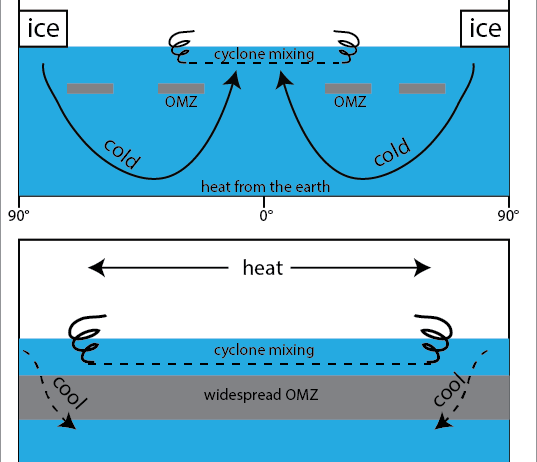The vast expanse of the Earth’s oceans harbors an intricate symphony of ecosystems and a delicate balance of salinity. This balance is crucial to marine life, ocean circulation, and global climate systems. However, as global warming accelerates, it has profound effects on ocean salinity patterns—a phenomenon that is garnering interest from the scientific community and environmental activists alike. Understanding how climate change modifies ocean salinity is essential for comprehending broader environmental implications.
Salinity, defined as the concentration of dissolved salts in water, can have significant implications for ocean dynamics. It influences density, which in turn affects water stratification, circulation patterns, and the distribution of marine species. The average salinity of ocean water is approximately 35 parts per thousand, but this average hides a complex web of variability influenced by a variety of factors.
One of the most critical drivers of salinity changes is the alteration in global precipitation patterns due to rising temperatures. As the planet warms, the hydrological cycle intensifies. This intensification results in greater evaporation rates and altered rainfall distributions. Regions that experience more rainfall may witness a dilution of salt concentrations, while arid areas could face increases in salinity due to higher evaporation rates leading to concentration. This phenomenon is particularly evident in coral reef ecosystems, where slight changes in salinity can have catastrophic effects on coral health and resilience.
Moreover, the melting of polar ice caps and glaciers introduces significant quantities of freshwater into the ocean. This influx contributes to lower local salinity levels, particularly in the Arctic and Antarctic regions. The alteration of salinity in these areas not only affects marine ecosystems but also disrupts the delicate balance of ocean currents. Ocean currents, driven by differences in temperature and salinity, play a pivotal role in regulating climate by transporting heat around the globe. As freshwater continues to flow into saltier waters, the driving force of currents could significantly weaken, potentially leading to catastrophic climatic shifts.
The phenomenon of stratification further exacerbates the challenges associated with changing salinity levels. As salinity levels shift, ocean layers become more distinct, impacting the mixing of water. Stable layers suppress nutrient mixing from deeper waters to the surface, resulting in decreased primary productivity. This lack of nutrients directly influences the food web, ultimately impacting fish populations and, consequently, human communities that rely on these resources for their livelihood.
Changes in ocean salinity can also induce shifts in marine species distribution. Certain species are adapted to precise salinity ranges; even minor deviations can affect their reproductive success, survival, and overall biodiversity. For instance, organisms like fish and plankton, which form the basis of marine food chains, may migrate to areas that are more suitable for their survival, potentially leading to overexploitation in those areas and underutilization in others. This migratory phenomenon can also cause challenges for fisheries management, as traditional fishing grounds may shift unexpectedly.
Additionally, ocean acidification, another consequence of climate change, interacts with salinity alterations to create a double bind on marine ecosystems. High levels of carbon dioxide in the atmosphere lead to increased carbonic acid in seawater, which not only impacts organisms with calcium carbonate shells but also affects overall ecosystem health. The interaction between acidification and varying salinity can be particularly detrimental to shellfish populations and coral reefs, both of which are vital components of marine ecosystems.
The socio-economic implications of these changes are profound. As commercial fish stocks decline due to changing salinity and the resulting impact on marine ecosystems, coastal communities that depend on fishing may suffer economic losses. Furthermore, with the changing environmental conditions, competition for marine resources may escalate, leading to geopolitical tensions among nations reliant on the oceans for sustenance and trade. This interconnectedness lays bare the need for collaborative governance structures to ensure sustainable marine resource management.
Many argue that robust action to mitigate climate change is essential to curtail the ongoing shifts in ocean salinity. By reducing greenhouse gas emissions and adopting renewable energy sources, society can help stabilize global temperatures and slow the melting of polar ice caps. Such efforts are not only vital for the oceans but also for the overall health of the planet’s ecosystems.
Lastly, enhancing scientific research to monitor changes in ocean salinity and the resulting impact is of paramount importance. Understanding the intricate relationships between salinity, marine life, and climate dynamics will enable better predictions of future conditions. Public engagement and education about the significance of ocean salinity can further galvanize support for climate action, encouraging individuals to take responsibility for their environmental footprint.
In summary, the interplay between global warming and ocean salinity is a highly complex and consequential issue. Changes in salinity driven by altered precipitation patterns, ice melt, and evaporation have far-reaching implications that extend beyond marine ecosystems to affect human communities and global climate. Addressing this challenge requires immediate and concerted efforts, grounded in science and aimed at fostering sustainable practices. Only through collective action can we hope to preserve the health of our oceans and, by extension, the planet as a whole.








